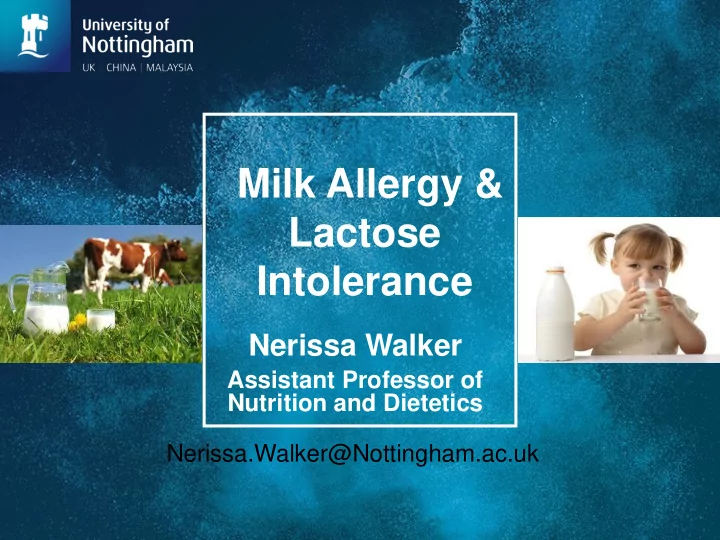

Milk Allergy & Lactose Intolerance Nerissa Walker Assistant Professor of Nutrition and Dietetics Nerissa.Walker@Nottingham.ac.uk
Outline of the session By the end of the session you should be able to:- • Describe the differences between a lactose intolerance and milk allergy • Identify the main symptoms of a lactose intolerance and milk allergy • Identify lactose and milk alternatives • Consider the possible nutritional implications of excluding cows milk and including alternatives
Non-dairy product growth Globally, sales of non-dairy milk more than doubled between 2009-2015 to $21bn From 2017-2020 soya is predicted to increase by 9% while cereal and nut-based ingredients to grow by 30% Perceived to have beneficial alternative nutrients to cows milk Euromonitor, 2017
Influences on consumers • Traditionally, products are used by those who have a lactose intolerance or a milk allergy • However, non-dairy plant based milk and products are no longer seen as primarily for people with a dietary restriction • Becoming more main stream as more consumers follow a plant-based diet • Perceived health and wellbeing benefits such as, lowering cholesterol and containing omega 3 fats and fibre
Milk allergy
Milk allergy • Leading cause of food allergy • 2-3% of infants and children have a cows milk allergy • Usually occurs before the age of 6 months • Almost 90% of children will react to other mammalian milks – goat, buffalo or sheep milk • About 90% of children will grow out of a milk allergy by the age of 5 • 1 in 200 will continue or develop a milk allergy in adulthood
Milk allergy (IgE mediated) Can be an immediate onset allergic reaction Symptoms include:- • Urticaria • Vomiting • Diarrhoea • Swelling • Breathing difficulties • Anaphylaxis
Milk allergy (Non IgE mediated) Onset can also be within hours or days Symptoms include:- • Eczema • Acid reflux • Abdominal pains • Constipation/diarrhoea • Blood/mucus stools • Bloating • Catarrhal symptoms • Tiredness
Milk free diet • Treatment is the avoidance of cow, goat, buffalo and sheep milk and all associated products including margarine, butter, yoghurt, ice cream, custard, cheese, evaporated milk. Check food labels for: Skimmed milk powder Hydrolysed whey protein Casein Milk powder Lactalbumin Whey Milk sugar Sodium caseinate Whey protein Non fat milk solids Calcium caseinate Lactose
Milk free diet
Milk free diet
Milk free diet
Lactose intolerance
Lactose intolerance • A lactose intolerance is the inability to digest the milk sugar (lactose) due a lactase deficiency. • Symptoms include:- - Bloating - Flatulence - Diarrhoea - Stomach cramps - Nausea
Types of lactose intolerance Primary lactose intolerance:- - Genetically inherited - Age related - Decrease in lactase activity - Permanent Secondary lactose intolerance:- - Usually temporary - Caused by damage to the bowel lining where lactase is produced - Occurs at any age
Lactose free diet • Treatment is avoiding or reducing cow, goat, buffalo and sheep milk and all associated products including margarine, yoghurt, ice cream, custard, some cheeses, evaporated milk. Check food labels for: Skimmed milk powder Hydrolysed whey protein Casein Milk powder Lactalbumin Whey Milk sugar Sodium caseinate Whey protein Non fat milk solids Calcium caseinate Lactose
Lactose free diet • Reducing or eliminating lactose from the diet to help manage symptoms. • Short or life-long lactose avoidance. • Amount of lactose to include/exclude is individual. • Use naturally lactose free, low lactose and lactose free alternatives.
Lactose free diet
Potential nutritional consequences • Cows milk is a good source of calcium, protein and fat soluble vitamins • If milk and milk products and associated nutrients are excluded or reduced, it may lead to nutritional deficiencies. • Reduced dietary calcium and vitamin D can have an affect on bone health • Consider the nutritional value of plant-based milk and products when using in food products
Plant based milk nutritional considerations Consider which milk free alternative/s are the most appropriate to your product and market Higher fibre 0.8g/100ml Higher saturated fat Low protein content 1.9g/100ml Higher protein (0.1g/100ml) 3g/100ml
Any Questions?
Food labelling
Useful resources • British Dietetic Association food facts https://www.bda.uk.com/foodfacts/milkallergy.pdf • NHS choices on lactose intolerance http://www.nhs.uk/Conditions/lactose-intolerance/Pages/Introduction.aspx • Cows milk allergy http://www.cowsmilkallergy.co.uk • Allergy UK https://www.allergyuk.org/assets/000/000/514/AUKOB_- _Guide_to_Food_Allergy2_original.pdf?1492601191 • Food Standards Agency – Understanding of food labelling terms used to indicated the absence or reduction of lactose, milk or dairy. https://www.food.gov.uk/sites/default/files/multimedia/pdfs/publication/understand foodlabelling.pdf
Recommend
More recommend